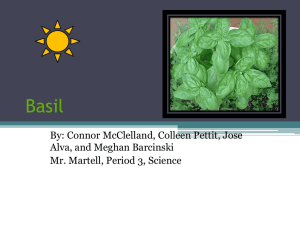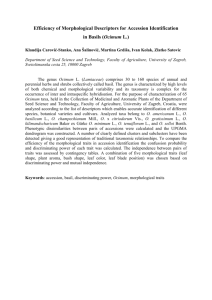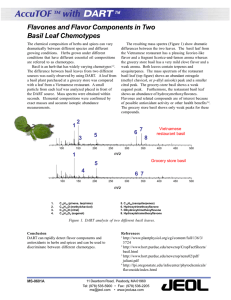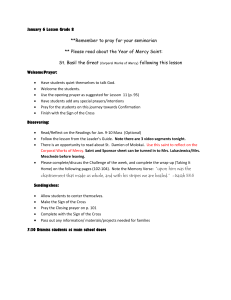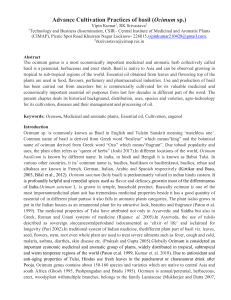Asian Journal of Agricultural Sciences 4(1): 1-4, 2012 ISSN: 2041-3890
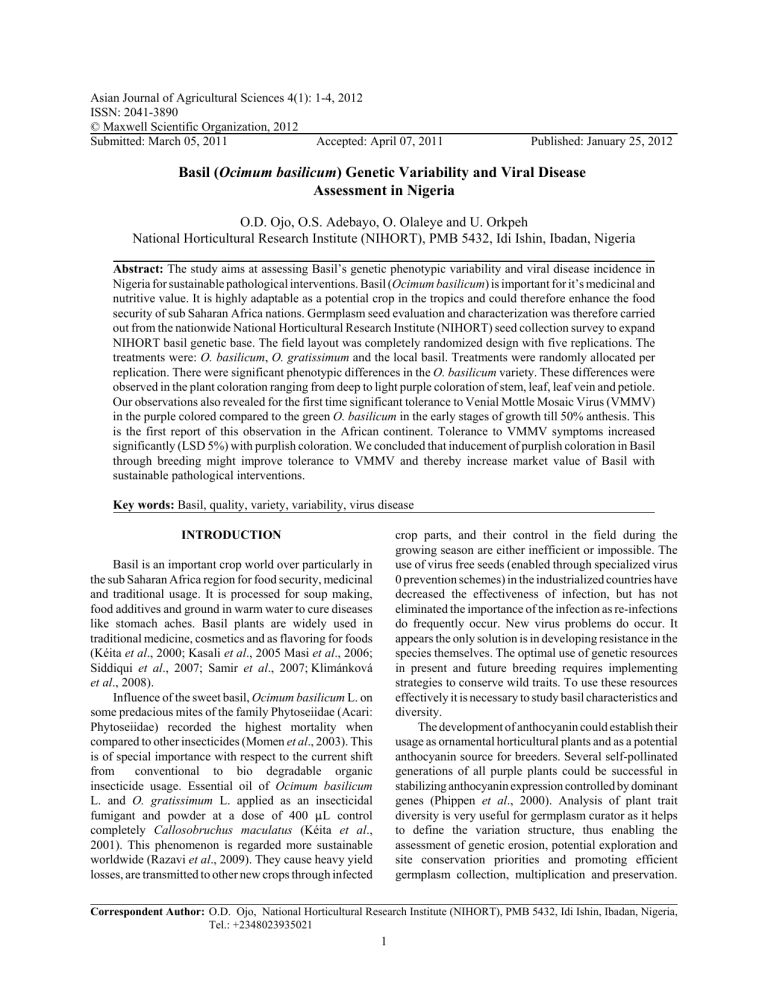
Asian Journal of Agricultural Sciences 4(1): 1-4, 2012
ISSN: 2041-3890
© Maxwell Scientific Organization, 2012
Submitted: March 05, 2011 Accepted: April 07, 2011 Published: January 25, 2012
Basil (Ocimum basilicum) Genetic Variability and Viral Disease
Assessment in Nigeria
O.D. Ojo, O.S. Adebayo, O. Olaleye and U. Orkpeh
National Horticultural Research Institute (NIHORT), PMB 5432, Idi Ishin, Ibadan, Nigeria
Abstract: The study aims at assessing Basil’s genetic phenotypic variability and viral disease incidence in
Nigeria for sustainable pathological interventions. Basil ( Ocimum basilicum ) is important for it’s medicinal and nutritive value. It is highly adaptable as a potential crop in the tropics and could therefore enhance the food security of sub Saharan Africa nations. Germplasm seed evaluation and characterization was therefore carried out from the nationwide National Horticultural Research Institute (NIHORT) seed collection survey to expand
NIHORT basil genetic base. The field layout was completely randomized design with five replications. The treatments were: O. basilicum , O. gratissimum and the local basil. Treatments were randomly allocated per replication. There were significant phenotypic differences in the O. basilicum variety. These differences were observed in the plant coloration ranging from deep to light purple coloration of stem, leaf, leaf vein and petiole.
Our observations also revealed for the first time significant tolerance to Venial Mottle Mosaic Virus (VMMV) in the purple colored compared to the green O. basilicum in the early stages of growth till 50% anthesis. This is the first report of this observation in the African continent. Tolerance to VMMV symptoms increased significantly (LSD 5%) with purplish coloration. We concluded that inducement of purplish coloration in Basil through breeding might improve tolerance to VMMV and thereby increase market value of Basil with sustainable pathological interventions.
Key words: Basil, quality, variety, variability, virus disease
INTRODUCTION
Basil is an important crop world over particularly in the sub Saharan Africa region for food security, medicinal and traditional usage. It is processed for soup making, food additives and ground in warm water to cure diseases like stomach aches. Basil plants are widely used in traditional medicine, cosmetics and as flavoring for foods
(Kéita et al ., 2000; Kasali et al ., 2005 Masi et al ., 2006;
Siddiqui et al ., 2007; Samir et al ., 2007; Klimánková et al ., 2008).
Influence of the sweet basil, Ocimum basilicum L. on some predacious mites of the family Phytoseiidae (Acari:
Phytoseiidae) recorded the highest mortality when compared to other insecticides (Momen et al ., 2003). This is of special importance with respect to the current shift from conventional to bio degradable organic insecticide usage. Essential oil of Ocimum basilicum
L. and O. gratissimum L. applied as an insecticidal fumigant and powder at a dose of 400
:
L control completely Callosobruchus maculatus (Kéita et al .,
2001). This phenomenon is regarded more sustainable worldwide (Razavi et al ., 2009). They cause heavy yield losses, are transmitted to other new crops through infected crop parts, and their control in the field during the growing season are either inefficient or impossible. The use of virus free seeds (enabled through specialized virus
0 prevention schemes) in the industrialized countries have decreased the effectiveness of infection, but has not eliminated the importance of the infection as re-infections do frequently occur. New virus problems do occur. It appears the only solution is in developing resistance in the species themselves. The optimal use of genetic resources in present and future breeding requires implementing strategies to conserve wild traits. To use these resources effectively it is necessary to study basil characteristics and diversity.
The development of anthocyanin could establish their usage as ornamental horticultural plants and as a potential anthocyanin source for breeders. Several self-pollinated generations of all purple plants could be successful in stabilizing anthocyanin expression controlled by dominant genes (Phippen et al ., 2000). Analysis of plant trait diversity is very useful for germplasm curator as it helps to define the variation structure, thus enabling the assessment of genetic erosion, potential exploration and site conservation priorities and promoting efficient germplasm collection, multiplication and preservation.
Correspondent Author: O.D. Ojo, National Horticultural Research Institute (NIHORT), PMB 5432, Idi Ishin, Ibadan, Nigeria,
Tel.: +2348023935021
1
Asian J. Agric. Sci., 4(1): 1-4, 2012
Moreover, these studies aid plant breeders in its utilization. In this sense the Basil species used in this study are potential sources of novel genes for Basil breeding as they show varied resistance to diseases and plant quality traits. Sweet basil ( Ocimum basilicum ) veinal mottle mosaic virus, which produces chlorotic spots and leaf deformation, caused by whitefly sp. in
Nigeria has not been reported. The disease symptom spreads fast and could wipe entire plantation. Thus swift intervention strategies are paramount for future sustainability. This study therefore, aims at assessing
Basil‘s genetic phenotypic variability and viral disease incidence in Nigeria for sustainable pathological interventions.
MATERIALS AND METHODS
The studies were carried out at the experimental research fields of the National Horticultural Research
Institute of Nigeria (NIHORT), Ibadan, Nigeria. Ibadan is located on latitude 7º30
!
N and longitude 3º54
!
E, 168 m a.s.l. Annual temperature ranges from an average minimum of 21ºC to a mean maximum of 32ºC while mean monthly relative humidity ranges between 61 and
83%. The study was conducted during two consecutive cropping seasons of year 2010 rainfall periods.
Agronomic practices used in the study: Three Basil varieties: Ocimum basilicum , Ocimum gratissimum and the local basil collected from the National Horticultural
Research Institute (NIHORT) Spices Programme nationwide germplasm survey were used. The soil used was sandy loam in texture. The experimental site had been left to fallow before the cropping seasons.
The Soil used in the report was ploughed and harrowed. Basal dressing of 60 kg/ha of nitrogen, phosphorus and potassium were each applied as NPK
15:15:15. These were applied 2 Weeks after Planting
(WAP) by incorporation into the soil using hand hoe.
Seeds were raised in the nursery and later transplanted at
3WAP to spacing of 0.50×0.50 m at one plant per stand.
Net plot size was 5 m 2 . The experimental design was
Randomized Complete Block design with 5 replications.
Weeds were hand-hoed at 2, 5 and 8 WAP. Cypermethrin at 50 g.a.i. per ha was sprayed against insects, starting from 3 WAP and at fortnightly interval until 9 WAP.
Procedure for the genetic and disease symptom measurements: Basil data observations were taken at 3 weeks intervals for purplish anthocyanin pigmentation on plant parts (stem, petiole, leaf and leaf vein), pathogenic chlorotic spots incidence, tolerance and leaf deformation severity. Data observation started from 3 Weeks after
Planting (WAP) to 15 WAP. At each observation time, five plants were randomly sampled per plot from two rows bordering reference centre plant. A final sample was taken at physiological maturity (15 WAP). Veinal
Mottle Mosaic Disease (VMMD) symptom incidence was determined as chlorotic lesion spot more than 0.25 mm on leaf surface. VMMD tolerance was determined as chlorotic spots covering less than 0.25% leaf surface area;
VMMD severity was determined as chlorotic spots covering more than 0.25% leaf surface area with leaf deformation.
These symptoms were rated on a symptom scale ranging from 0 to 5, where, 0 = nil, 1 = very low, 2 = low,
3 = medium, 4 = high, and 5 = very high pathological chlorotic spot disease infection symptom. These score ratings per observation were added up divided by number of observation and then divided by number of replications sampled.
RESULTS AND DISCUSSION
There were significant phenotypic and viral disease symptom differences among the four varieties that were evaluated. These differences were observed in plant coloration ranging from deep to light purple coloration of stem, leaf, leaf vein and petiole, as shown in Table 1.
Analysis of plant diversity is very useful for germplasm curator as it helps to define the variation structure, thus enabling the assessment of genetic erosion, potential exploration and site conservation priorities and promoting efficient germplasm collection, multiplication and preservation. Moreover, these studies aid plant breeders in its utilization. In this sense the local Basil specie is a potential source of novel genes for Basil breeding as it shows resistance to disease and plant quality traits. Basil variety ODV1/10 in particular was observed to be significantly deep purple compared to light purple
ODV2/10 while ODV3, O. gratissicum and the local varieties were green pigmented throughout. Our results support the hypothesis that the central self-incompatible populations would be the oldest living biotypes from which the others were derived. As the species migrated northward and southward, self-incompatibility was replaced by self-compatibility possibly as a result of selection favored by the sparse populations and because of fewer and weedier genotypes. This pattern of variation resembles the emancipation of the recessives phenomenon when populations migrate far from their centre of diversity. We asserted that as populations move away from the region of origin, the genetic diversity is diminished and the frequency of homozygotes rises.
Chang et al . (2008) reported that solar irradiation affected basil growth and quality which might justify our findings of assessing variability due to plant pigmentation. The high variability that we found in this study could be due to different factors. This tropical area is part of the hypothetical tropical region conducive to ancestors of this species, which would explain the greater diversity. Also, the location of this area in the middle of
2
Asian J. Agric. Sci., 4(1): 1-4, 2012
Table 1: Color variations in basil
Variety*
Plant part
------------------------------------------------------------------------------------------------------------------------------------------------------------
ODV1/10 ODV2/10 ODV3/10 O. gratisimum Local
Leaf
Stem
Petiole
Vein
Purple
Purple
Purple
Purple light purple light purple light purple light purple
Green
Green
Green
Green
Green
Green
Green
Green
Green
Green
Green
Green
*: ODSV1/10: Ojo David Solanum variety1collected 2010; ODSV2/10: Ojo David Solanum variety 2 collected 2010; Local: Indigenous land race local variety
Table 2: Basil tolerance to veinal mottle mosaic disease at 50% anthesis
Variety*
Symptom+
Incidence
Tolerance
-----------------------------------------------------------------------------------------------------------------------------
ODV1/10 ODV2/10 Local
2.0
8.1
3.0
6.8
5.2
6.2
3.0
5.4
2.2
8.8
LSD (5%)
0.18
1.20
Severity 5.0
6.6
8.0
8.0
4.0
0.33
*: ODSV1/10: Ojo David Solanum variety1collected 2010; ODSV2/10: Ojo David Solanum variety 2 collected 2010; Local: Indigenous land race local variety; +: Incidence: Mean number of plant(s) infected across replications; Tolerance: Index of disease symptom appearance before economic threshold; Severity: Index of disease symptom damage after economic threshold tropical geo-climate and habitats could permit the incorporation of diversity from nearby regions, thus augmenting biodiversity and limiting the genetic flow between the North and the South.
Viral disease incidence was significantly lowest at
50% anthesis for ODV1/10 followed by the local variety.
Incidence was significantly highest for the variety
ODV3/10 (Table 2). Basil tolerance to Veinal Mottle
Mosaic Disease (VMMD) was found to be significant in the order: Local = ODV1/10>ODV2/10 = ODV3/10 = O.
gratissicum (Table 2). Basil VMMD severity was found to be significant in the order: O. gratissicum = ODV3/10>
ODV2/10>ODV1/10>Local (Table 2).
Our findings revealed for the first time significant tolerance to Venial Mottle Mosaic Virus (VMMV) in the purple colored compared to the green varieties of
O. basilicum in the early stages of growth till 50% anthesis. This is the first observation and reporting in the continent. Similar pathological cases reported 2009 in other continent (Davino et al ., 2009; Ronco et al ., 2009) indicated the authenticity of the current situation in
Africa. Tolerance to VMMV symptoms increased significantly with purplish coloration.
CONCLUSION
We concluded that inducement of purplish coloration in Basil through breeding with sustainable pathological interventions might improve tolerance to VMMV and thereby increase market value of Basil.
ACKNOWLEDGMENT
The lead author of this report wishes to thank the
NIHORT internal management committee for conducive research environment and financial assistance to carry out this investigation. Special regards as well to Prof. D.K.
Ojo (University of Agriculture, Abeokuta) for taking time out of his busy schedules, during his sabbatical period in
NIHORT, to edit this manuscript.
REFERENCES
Chang, X.M., P.G. Alderson and C.J. Wright, 2008. Solar irradiance level alters the growth of basil (
Experimental Bot., 63(1-3): 216-223. basilicum
Pathology, 58(2): 407.
chemotype of ( Ocimum basilicum
Ocimum basilicum L.) and its content of volatile oils. Environ.
Davino, S., G.P. Accotto, V. Masenga, L. Torta,
M. Davino, S. Davino, G.P. Accotto, V. Masenga,
L. Torta and M. Davino, 2009. Basil ( Ocimum
), a new host of Pepino mosaic virus. Plant
Samir, D.C., M.B. Sukalyan, B.D. Chakraborty and
S.M. Abhijit, 2007. Biosorption of cesium-137 and strontium-90 by mucilaginous seeds of Ocimum basilicum . Bioresour. Technol., 98(15): 2949-2952.
Kasali, A.A., A.O. Eshilokun, S. Adeola, P. Winterhalter,
H. Knapp, B. Bonnlander, W.A. Koenig,
A.A. Kasali, A.O. Eshilokun, S. Adeola,
P. Winterhalter, H. Knapp, B. Bonnlander and
W.A. Koenig, 2005. Volatile oil composition of new
L.) from Nigeria.
Flavour Fragrance J., 20(1): 45-47.
Kéita, S.M., C. Vincent, J.P. Schmit, J.T. Arnason,
A. Bélanger, S.M. Kéita, C. Vincent, J.P. Schmit,
J.T. Arnason and A. Bélanger, 2001. Efficacy of essential oil of Ocimum basilicum L. and O.
gratissimum L. applied as an insecticidal fumigant and powder to control Callosobruchus maculatus
(Fab.) [Coleoptera: Bruchidae]. J. Stored Prod. Res.,
37(4): 339-349.
Kéita, S.M., C. Vincent, J. P. Schmit, A. Bélanger,
S.M. Kéita, C. Vincent, J. P. Schmit and A. Bélanger,
2000. Essential oil composition of ( Ocimum basilicum L., O. gratissimum L.
and O. suave L.) in the Republic of Guinea. Flavour Fragrance J., 15(5):
339-341.
3
Klimánková, E. Holadová, K. Hajšlová, T. Jajka,
J. Poustka and M. Koudela, 2008. Aroma profiles of five basil ( Ocimum basilicum L.) cultivars grown under conventional and organic conditions. Food
Chem., 107(1): 464-472.
Masi, L., D. Siviero, P.C. Esposito, D. Castaldo, F. Siano,
B. Laratta, L. Masi, P.D. Siviero, C. Esposito,
D. Castaldo, F. Siano and B. Laratta, 2006.
Assessment of agronomic, chemical and genetic variability in common basil ( Ocimum basilicum L.) genotypes, belonging to nine known cultivars grown in Italy. Euro. Food Res. Technol., 223(2):
273-281.
Momen, F.M., S.A.A. Amer, F.M. Momen and
S.A.A. Amer, 2003. Influence of the sweet basil,
( Ocimum basilicum L .
) on some predacious mites of the family Phytoseiidae (Acari: Phytoseiidae). Act.
Phytopathol. Entomol. Hungarica, 38(1-2): 137-143.
Asian J. Agric. Sci., 4(1): 1-4, 2012
Phippen, W.B., J.E. Simon, W.B. Phippen and
J.E. Simon, 2000. Anthocyanin inheritance and instability in purple basil ( Ocimum basilicum L). J.
Heredity, 91(4): 289-296.
Razavi, S.M.A.S., A. Mortazavi, L. Matia-Merino,
S.H. Hosseini-Parvar, A. Motamedzadegan,
E. Khanipour, S.M.A. Razavi, S.A. Mortazavi,
L. Matia-Merino, S.H. Hosseini-Parvar, A.
Motamedzadegan and E. Khanipour, 2009.
Optimisation study of gum extraction from Basil seeds ( Ocimum basilicum L). Inter. J. Food Sci.
Technol., 44(9): 1755-1762.
Ronco, L., C. Rollán, Y.J. Choi, H.D. Shin, L. Ronco,
C. Rollán, Y.J. Choi and H.D. Shin, 2009. Downy mildew of sweet basil ( Ocimum basilicum ) caused by
Peronospora sp. in Argentina. Plant Pathol., 58(2):
395.
Siddiqui, B.S., S.T. BegumAli, B.S. Siddiqui and
S.T. Ali, 2007. New cinnamic acid esters from
Ocimum basilicum . Nat. Prod. Res., 21(8): 736-741.
4
